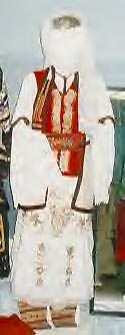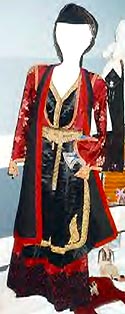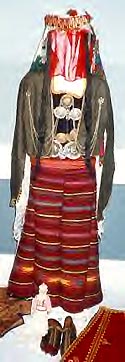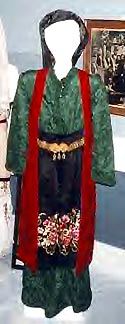
|
|||||||
| |||||||
MAP | GREEK VERSION | ONLY TEXT | CREDITS |
 |
COSTUMES FROM EPIRUS | |

|
DROPOLIS The costume of Dropolis was worn in the region of Dryinoupolis-Dropolis, in the villages of the flat lands surrounding Argyrokastro. This area has close relations with the region of Pogoni, thus explaining many of the similarities noticeable in the costumes, with as principal characteristic the white segouni and all the basic features of the Greek costume. Throughout this geographical area, such as in Lidzouria, Zagora, Delvino, Tepeleni and Premeti, are maintained the manners, habits and traditional customs which demonstrate an interrupted course of Greek heritage. The women of Dropolis like those of Hassia and other regions tattooed a cross on their forehead as a protection against Moslem dervishes. The costume, either everyday or festival or bridal wear, consisted of the white cotton, or a silk chemise, skirt, a substitute for the usual dickey, bib or a white summer mantel, sleeveless vest, an apron, wool belt, a golden belt, knitted white stockings. To the headdress belong a red, velvet fez, silk veil, crepe kerchief, a white band tied to the head and a white cotton kerchief. The ornaments of the costume are small silver clasps, cross, silver plated buckle, chains for the chest, earrings, rings and bracelets. Benaki Museum |
|
KONITSA These costumes are still worn by the villagers and they represent significant stages of their life. An old Epirot market town, Konitsa was renowned throughout the area for the commercial activities of its inhabitants. Many of them emigrated, bringing back money on their return as well as more modern life-styles. Quite early the women began to cover their traditional blouses with long bourgeois style dresses, but retained their typical Epirot sigounia and flokates. A sleeveless woven wool pinafore dress, gathered at the waist and embroidered round the hem, was worn as a petticoat for extra warmth. The material for the main dress, which was sewn by tailors, was generally oriental silk, but it could be a fine bought woolen cloth or cotton-silk mixture with stripes, and later velvet. The bodice, cuffs and hem were also trimmed with velvet bands. The sigouni was stitched and embroidered in red and gold by local tailors. The apron is made of silk, with colorful silk decoration. One or two rows of gold coins adorned the bodice. They tied a dark-colored silk or woolen scarf with a crocheted trim around the head. On chilly days, the women wore a floukata, which was sewn from a thick black woven cloth and likewise embroidered by a tailor, using strips of red felt and silk ribbons. Dora Stratou Theater | |

|
METSOVO Metsovo was inhabited by Vlachs, who originated from an area known to us today as Romania. The Vlachs were a nomadic tribe, that moved slowly to the south. Upon reaching the Metsovo area, they ceased their wandering and decided to settle there. The costume shown here is similar to the costumes worn in the Zagori and Konitsa regions of Epirus and was also worn as a bridal costume or on other special occasions. The costume consists of a long dress made of oriental silk. Rich velvet fabric is cut out in a floral-like pattern and applied to the hem of the dress, revealing the silk fabric beneath it. This western style of dress included a dark-colored apron, hand-embroidered with colored silk thread along the bottom hem line. The overcoat, the flokata, unlike its western counterpart, was originally patterned after a "villager's" overcoat. In present day, it is narrower and of a more elegant design, truly complementing the dress beneath it. The woman's hair is braided and covered with a silk scarf, originally tied at the back. Today the scarf is tied over the head. A silver filigree belt is worn around the waist. Rows of gold coins adorn the bosom. Hand-knit, white, wool stockings and flat-laced shoes of black leather are also worn. Ioanna Papantoniou |

|
POGONI The region of Pogoni is spread over valleys and plateaus in the northern part of Epiros, beyond ancient Dodoni, extending as far an imaginary line separating it from the villages of Dropoli. The infertile cornfields and vineyards obliged the men of the area to seek their fortune elsewhere, some finding work and others left to their own devices, the women worked the fields and vineyards. The same outfit, with one or two variations, was worn in thirty villages. The costume of Pogoni is composed of the following pieces: the undershirt, chemise, a good coat made of wool from Constantinople or an everyday one, jacket, the pesili of the bride, extra sleeves, belt, mantel with the sleeves, apron, kerchief for the waist of the bride, stockings, knee socks, shoes. The everyday and festival headdress is the obola. The bridal headdress consists of a silk kerchief or red fez, silk tassels, added hair, a white, silk kerchief, a fine red kerchief. Rich ornaments complete the headdress: an ornament of the forehead, earrings, silver ornaments for the top of the head and chains with coins. Ornaments of the costume are buttons, a chest ornament, buckle, dickey, bracelets and rings.
Benaki Museum |

|
ZAGORI The villages of Zagori that cling to the sides of Mount Pindos, and to which access was difficult to prevent invasion, developed undisturbed a high standard of living during the difficult years of Turkish occupation, when the inhabitants of the towns and plains were suffering considerable hardship. According to the earliest information available regarding their costume, it was a bourgeois style, originally oriental but later western in character. It was worn in 46 villages with some variations. The flokata, the sleeveless overdress of the sigouni type is the only traditional feature of the costume. The other components of the dress have been influenced by the fashion prevailing at the end of the 19th century. Made of thick woolen fabric, the flokata was ornamented with red ribbons, panels of red felt and embroidered patterns of red twisted cord. The two rectangular panels of red felt at the sides of the overdress are called spatela. The black apron is embroidered with bright flowers and the edge with knitted black lace on the hem. The jewelry is an ornamental belt-buckle. A black printed head-kerchief is tied in a special manner, known as oura mantili. In 1991, Paul Ginis traveled to the island of Tilos to conduct his research. Mr. Ginis observed the women still wearing this costume, signing their traditional songs and dancing their traditional dances. |